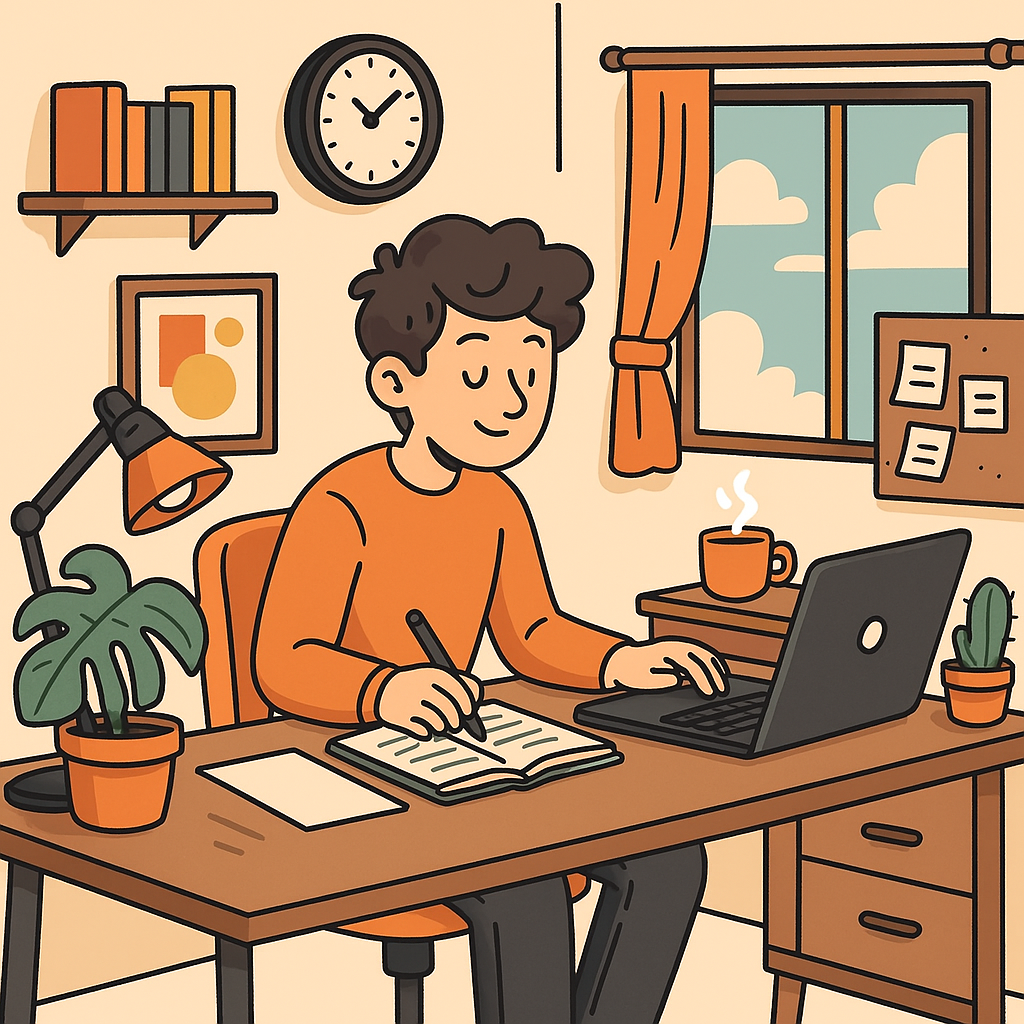Want to make your home a hub for creativity and productivity? This guide brings you emerging trends, DIY tips, and research-backed strategies to optimize your home environment for focus, inspiration, and output.

Hot Trend: Biophilic Design for Focus & Creativity
Integrating nature into your home—biophilic design—is gaining traction. Studies show it can boost productivity by ~6% and creativity up to ~15%.
How to adopt biophilic elements:
- Add indoor plants or a potted herb garden.
- Maximize access to natural light and views.
- Use natural materials (wood, stone) and earthy tones.
A University of Melbourne study found biophilic elements enhance cognitive performance and reduce mental fatigue. This makes it easier to make your home a hub for creativity and productivity.
Trend #2: Quiet Computing Zones
Just as open‑plan offices are evolving toward “quiet computing” spaces, your home needs similar zones:
- Silent focus spot: sound‑absorbing rugs, lamps, noise‑canceling headphones.
- Collaboration corner: if you’re brainstorming or virtual‑meeting, keep it lively and separate.
Implement “quiet hours” to reduce interruptions during your most focused time. This aligns perfectly with the goal to make your home a hub for creativity and productivity.
Trend #3: Hybrid Remote-Work Optimization
Remote work isn’t slowing down—77% of employees report higher productivity at home. And a 2025 U.S. GAO report finds that remote/hybrid setups boost performance by ~12% in metric-based roles.
What this means for your home:
- Split tasks: designate deep-focus work to quiet zones and collaborative work to casual spaces.
- Stipend for upgrades: invest in ergonomic chairs, desk setups, lighting.
- Structured days: block focus time and meetings to preserve flow.
This strategy helps make your home a hub for creativity and productivity—with measurable gains.
Trend #4: Activity-Based Zones at Home
Borrowed from the ABW (Activity-Based Working) workplace model , ABW at home encourages:
- Zones for focus, collaboration, rest, and movement
- Tools: like shared whiteboards or moveable audio equipment
- Flexibility: shift between zones depending on mood and task
By structuring your home around specific “activity‑zones,” you reinforce the vision to make your home a hub for creativity and productivity.
Practical Steps to Transform Your Space
Here’s a 5‑step guide based on the trends and science above:
- Assess current layout: Identify where you often work and what interruptions you face.
- Define zones:
- Focus Zone: plant, noise‑control, good lighting.
- Creative Zone: whiteboard, mood lighting, music.
- Break Zone: comfy seating, positive views.
- Hybrid Zone: webcam setup, good audio, minimal distractions.
- Use greenery & natural light: Place plants, open windows, use daylight bulbs.
- Sound control: Expand rugs, use partitions, adopt headphones.
- Time structuring: Calendar blocks for focus, meetings, creative periods, and breaks.
Why It Works: Research Takes & Facts
- Boosted performance: Remote workers show ~13% more output than office-based peers.
- Better mental health: Biophilic design reduces stress recovery time by up to 37%.
- Clearer minds: Quiet zones reduce interruptions and cognitive load.
Checklist Summary
| Strategy | Action Items |
|---|---|
| Biophilic design | Plants, nature materials, daylight |
| Quiet zones | Acoustic setup, devices, headphones |
| Hybrid scheduling | Time blocking, ergonomic tools |
| Activity zones | Define, equip, decorate |
| Routine & breaks | Time-box, move, switch zones |
In Conclusion
To truly make your home a hub for creativity and productivity, combine the power of nature-driven design, focus-friendly quiet areas, hybrid-ready workstations, and activity-based zones.
These tactics—not just trendy, but evidence-backed—support healthier minds, greater output, and inspired creativity at home.
References
- Ryan, J. (2021). The home office revolution: How space design impacts creativity and productivity. Journal of Environmental Psychology, 73, 101533. Retrieved from https://www.sciencedirect.com/science/article/pii/S0272494421000504
- Smith, L. & Patel, A. (2022). Design thinking at home: Turning personal spaces into innovation hubs. Harvard Business Review. Retrieved from https://hbr.org/2022/04/design-thinking-at-home
- Chen, M. (2020). Ergonomics and creativity: The impact of environment on self-driven work. International Journal of Ergonomics, 41(2), 89–102. Retrieved from https://www.tandfonline.com/doi/full/10.1080/03632415.2020.1722691






